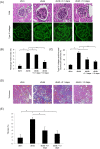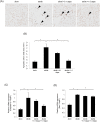Long-term treatment with the sodium glucose cotransporter 2 inhibitor, dapagliflozin, ameliorates glucose homeostasis and diabetic nephropathy in db/db mice
- PMID: 24960177
- PMCID: PMC4069074
- DOI: 10.1371/journal.pone.0100777
Long-term treatment with the sodium glucose cotransporter 2 inhibitor, dapagliflozin, ameliorates glucose homeostasis and diabetic nephropathy in db/db mice
Abstract
Inhibition of sodium glucose cotransporter 2 (SGLT2) has been reported as a new therapeutic strategy for treating diabetes. However, the effect of SGLT2 inhibitors on the kidney is unknown. In addition, whether SGLT2 inhibitors have an anti-inflammatory or antioxidative stress effect is still unclear. In this study, to resolve these issues, we evaluated the effects of the SGLT2 inhibitor, dapagliflozin, using a mouse model of type 2 diabetes and cultured proximal tubular epithelial (mProx24) cells. Male db/db mice were administered 0.1 or 1.0 mg/kg of dapagliflozin for 12 weeks. Body weight, blood pressure, blood glucose, hemoglobin A1c, albuminuria and creatinine clearance were measured. Mesangial matrix accumulation and interstitial fibrosis in the kidney and pancreatic β-cell mass were evaluated by histological analysis. Furthermore, gene expression of inflammatory mediators, such as osteopontin, monocyte chemoattractant protein-1 and transforming growth factor-β, was evaluated by quantitative reverse transcriptase-PCR. In addition, oxidative stress was evaluated by dihydroethidium and NADPH oxidase 4 staining. Administration of 0.1 or 1.0 mg/kg of dapagliflozin ameliorated hyperglycemia, β-cell damage and albuminuria in db/db mice. Serum creatinine, creatinine clearance and blood pressure were not affected by administration of dapagliflozin, but glomerular mesangial expansion and interstitial fibrosis were suppressed in a dose-dependent manner. Dapagliflozin treatment markedly decreased macrophage infiltration and the gene expression of inflammation and oxidative stress in the kidney of db/db mice. Moreover, dapagliflozin suppressed the high-glucose-induced gene expression of inflammatory cytokines and oxidative stress in cultured mProx24 cells. These data suggest that dapagliflozin ameliorates diabetic nephropathy by improving hyperglycemia along with inhibiting inflammation and oxidative stress.
Conflict of interest statement
Figures








References
-
- Gilbertson DT, Liu J, Xue JL, Louis TA, Solid CA, et al. (2005) Projecting the number of patients with end-stage renal disease in the United States to the year 2015. J Am Soc Nephrol 16: 3736–3741. - PubMed
-
- Navarro-Gonzalez JF, Mora-Fernandez C, Muros de Fuentes M, Garcia-Perez J (2011) Inflammatory molecules and pathways in the pathogenesis of diabetic nephropathy. Nat Rev Nephrol 7: 327–340. - PubMed
-
- Hediger MA, Rhoads DB (1994) Molecular physiology of sodium-glucose cotransporters. Physiol Rev 74: 993–1026. - PubMed
Publication types
MeSH terms
Substances
LinkOut - more resources
Full Text Sources
Other Literature Sources
Medical
Molecular Biology Databases
Research Materials
Miscellaneous

